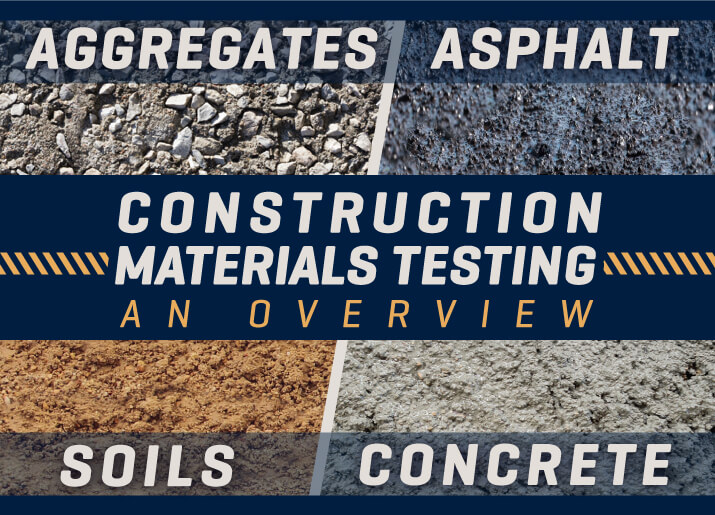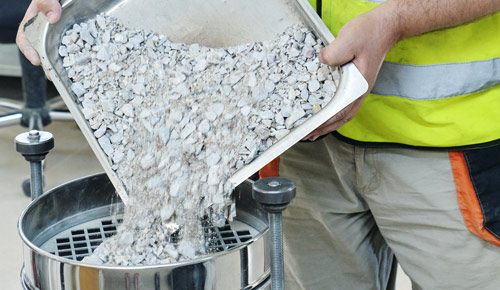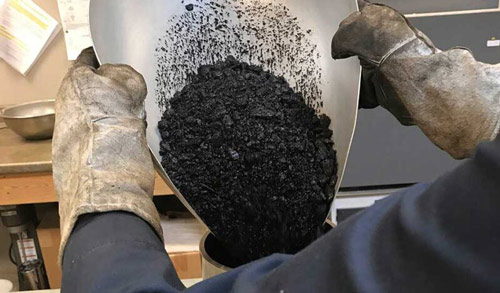
At Gilson, we spend a lot of time discussing the details and finer points of construction materials testing equipment and test methods. Still, sometimes the questions a customer needs answers to are more basic. We believe it can only help newcomers to the materials testing industry if we take some time to cover the fundamentals.
The term construction materials testing sounds like a catch-all term for analyzing everything from nails to doorknobs. However, for the civil engineering industry, it has come to mean the characterization of a handful of things by using specific test methods in a construction materials testing laboratory: concrete, aggregates, asphalt, and soils. This blog will take a high-altitude view of what construction materials are, the most important properties to test for, and the right equipment to get the job done.
This article includes links to product listings, blogs, or other sources to fill in the details. Individual product listings provide references to available ASTM and AASHTO standard test methods and practices, relevant Gilson Insights (blog), and informative videos.
Concrete
Construction materials testing of concrete begins long before the first batch is dispatched from the plant and may continue on concrete emplacements that are decades, even centuries, old.
Testing performed throughout the mix design process confirms the suitability of cement and other mix components. Fresh concrete is field-tested during placement, molded samples are tested for strength after curing, and hardened concrete is evaluated for structural sufficiency.

Fresh Concrete Testing
Tests on fresh concrete document compliance with specified mix design and project requirements and include concrete sampling and molding for later laboratory tests. Fresh concrete is typically sampled from the point of placement and tested for slump, air content, unit weight (density), and temperature tests. Cylinder or beam specimens are molded for strength tests and set aside for field curing. This previous blog post Concrete Cylinder Testing - From the Field to the Lab discusses making and testing concrete cylinders in detail.
Concrete Sample Curing
The curing of concrete samples takes place in two stages. For initial curing at the job site, concrete cylinder or beam samples are protected in curing boxes from temperature extremes, moisture loss, and disturbances until they gain enough strength for transport to the testing laboratory.
Upon arrival in the lab for final curing, the samples are stripped out of their sample molds and stored in specially built moist rooms or immersed in water-filled curing tanks until ready for testing.
Concrete Strength Testing
Most conventional concrete mixes are intended to reach their design strength at 28 days of age. As a rule of thumb, a 7-day old sample is on track for strength development if a strength test reaches a minimum of 2/3 of that goal.
Strength Testing for concrete cylinders and beams is performed in a concrete compression machine. For cylinders, the specimen ends are capped with capping compound or unbonded neoprene capping pads to evenly distribute compressive forces, then axially loaded until they fail. Flexural beam samples are supported at specific points along their length by special attachments, then loaded until failure.
Concrete Nondestructive Testing
Nondestructive test instruments estimate, measure, or confirm attributes of hardened concrete while causing little to no damage. These devices and test methods provide data to assess strength in hardened concrete, locate and measure steel reinforcement, detect reinforcing steel corrosion, monitor concrete cracking and movement, and more.
If 28-day strength tests are not satisfactory or defects in newly placed concrete are detected, additional in-place testing of the hardened concrete may be required. In older structures, factors prompting concrete quality assessment might be part of due diligence for a transfer of ownership, the discovery of structural damage, or proposed alterations to the building.
Concrete coring is a reliable approach to extracting hardened specimens for strength tests, visual or chemical analyses, or thickness measurements. However, this method requires the careful location of reinforcing steel and other embedded items before drilling to prevent significant structural damage. The cosmetic defacing of visible surfaces can also be an issue.
Aggregates
Aggregates originate from three primary sources: natural sand, gravel, or rock excavated or quarried from the ground, waste slag from iron and steel production, and recycled concrete. Aggregate construction materials make up 70% to 90% by volume of concrete and asphalt mixes and are used on their own as base courses for pavements. The particle size, gradation, individual shape, angularity, and durability of different aggregate blends influence the suitability of aggregates for each application.

Aggregate Sampling
Representative sampling is key to accurate results for any test method, especially for construction aggregates testing. Aggregates are sensitive to careless sampling, resulting in test specimens that do not reflect the original material. Splitters and sample dividers reduce bulk field samples to test specimen sizes while maintaining representative particle size distribution.
Aggregate Sieving and Screening for Particle Size
Particle size, size distribution, and overall gradation are basic aggregate properties, the key to classifying aggregate blends and predicting their performance. Test sieves, sieve shakers, and screen shakers are the primary instruments used for particle sizing of aggregates.
Aggregate Shape
Aggregate particle shape has a direct influence on the performance of asphalt and concrete mixes. Flat and elongated aggregate particles are difficult to consolidate during placement and resist reorientation, making them difficult to compact into a dense state. These particles also have a greater tendency to fracture. Aggregates with cubic shapes and sharp, angular surfaces add strength to concrete but create a high water demand. Rounded aggregates allow concrete to flow into voids more readily but may cause strength and segregation issues. In asphalt, rounded particles promote shoving and rutting of pavement surfaces. Aggregate shapes can be measured and evaluated with simple testing devices.
Aggregate Durability
Construction aggregates add strength, durability, and resistance to freeze/thaw cycles to concrete and asphalt mixes. Various testing instruments and methods measure aggregate hardness, toughness, abrasion resistance, and more to meet application specifications.
Asphalt
Asphalt binder liquid is classified according to its optimum performance for different applications and climates. Paving mixes are designed and tested in laboratory trials before being produced in batch plants for lay down on roadways. Verifying the thickness, density, and strength of recovered samples confirms the quality of completed pavements.

Asphalt Mix Design
Various types and proportions of liquid asphalt binder and aggregates are combined in trial asphalt mixes in the laboratory long before paving operations start. Typical tests at this stage focus on compressive strength, deformation under load, and preparation of samples to determine density, specific gravity, compactability, and the moisture sensitivity of each mix. Many tests from this design phase, especially for density, binder content, and compaction characteristics, are repeated as quality control confirmation when production starts.
Asphalt Binder Tests
Binder is the liquid asphalt cement (AC) that holds the aggregate particles together in an asphalt paving mixture. Asphalt binder tests measure viscosity, elastic, and shear strength at different temperatures, performance after aging, and other properties. Such tests help predict binder performance for various paving mixes and categorize binder types into different classes.
Asphalt Pavement Quality Testing
Materials testing doesn’t stop once the paving starts. Samples of the mix are collected for pavement quality control tests during the laydown of the asphalt. Thickness and density are measured in-place during placement, and core specimens are drilled for laboratory confirmation of layer depths, density, and void ratios. Deflection of the pavement under loads may be measured in place.
Soils
In terms of their use as construction materials, soils are roughly divided into two categories. Test methods for the two engineered applications are often unique, but some are shared, especially those related to particle size, strength, and behavior under different moisture contents.

Soils for earthwork applications are excavated or “borrowed” from natural deposits, then placed and compacted elsewhere as engineered fills. Earthwork fills and embankments may carry structures or pavements, retain bodies of water, or change the shape of the landscape for aesthetics. Soil tests for engineered fills focus on density, moisture-density relationships, shear strength, and particle size.
In their undisturbed natural state, soils must be evaluated for shear strength, potential consolidation, and behavior at different moisture contents before being loaded from structures or embankments. For dams, waterways, and landfills, in-situ soils are also studied for their permeability or hydraulic conductivity characteristics.
Soil Mechanics
The science of soil mechanics is the study of different strength properties of soils and how they react to variations in loading and moisture conditions. Lab testing for direct or triaxial shear strength under various loading conditions, estimates of consolidation, and response to varied moistures are critical for designing structural foundations.
Atterberg Limits
Atterberg Limits is a set of test methods to determine the moisture contents when silt and clay soils transition between solid, plastic, and liquid states and the degree of shrinkage when oven-dried. The liquid limit and plastic limit test results are used to calculate indices for plasticity, liquidity, consistency, and activity for cohesive soils.
Compaction and Density
Tests for engineered soil fills focus on finding the moisture-density relationship of the in-place fill material compared to benchmark density and moisture values established in the lab. The proposed soil material samples are procured in the field and transported to a construction material testing laboratory. One of the multiple Proctor test methods using different compaction energies and mold sizes is performed to arrive at the moisture-density relationship value.
Particle Size Analysis
Tests for particle sizing of granular soils are usually performed with test sieves and sieve shakers using conventional gradation methods. Hydrometer analysis is required when particle size information for soils with significant clay and silt content is needed. For this procedure, a special glass hydrometer measures the density of the finer fraction of the soil in a water suspension. Over several hours or more, additional density readings are taken as the soil particles settle out of suspension. Particle size is calculated by comparing density readings to elapsed time. This Soil Hydrometer Testing blog takes a deep dive into the method and equipment used.
Permeability
Soil Permeability, also known as hydraulic conductivity, measures the speed at which water flows through a soil matrix. These flow rates are computed using Darcy’s law and are expressed as the coefficient of permeability (K), the velocity in centimeters per second of water flow. This information is valuable for geotechnical and civil engineers, hydrogeologists, soil and environmental scientists for structural foundations, embankments, earthen dams, flood management, and effluent infiltration.
A variety of standard test methods describe practices for measuring permeability in the laboratory or on soils in-place in field settings. The common theme is that water under head pressure flows through the soil medium, and the rate of water ingress or outflow is measured. A recent Gilson blog explains soil permeability in detail.
Classification and Field Testing
Some soil tests must be performed in the field: density tests to measure soil compaction, static or dynamic cone penetration, and soil resistivity testing, to name a few. There are several classification and field testing methods and systems used for soils and many more modifications to these systems. The most popular visual/manual systems are variations of the Burmister system. ASTM and AASHTO methods depend partly on laboratory test results to classify soils.
Additional Resources
Temperature and Humidity Measuring Instruments
We hope this broad overview of construction materials testing has helped with your understanding of the industry. There is much more detail in the blogs, videos, and product listings on the Gilson website to fill in the blanks, and our experienced Technical Support staff is always ready to help with your application.
Gilson Is Here to Help
Contact our testing experts for more information or to discuss your testing application.
Testing Resources
Standard Test Methods, Specifications, and Practices
Individual test methods and specifications referenced in our product descriptions, blog articles, and videos are available for review or purchase from the professional organizations noted.
- ASTM International (American Society for Testing and Materials)
- AASHTO (American Association of State Highway and Transportation Officials)
- ACI (American Concrete Institute)
- State DOTs (Departments of Transportation)
- ISO (International Organization for Standardization)
- BS (British Standards)
- EN (European Standards)

















